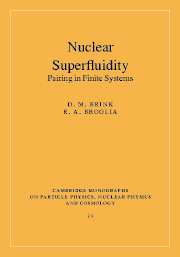Book contents
- Frontmatter
- Contents
- Preface
- 1 Introduction
- 2 The pairing force and seniority
- 3 The BCS theory
- 4 Spontaneous symmetry breaking
- 5 Pairing vibrations
- 6 Phase transitions
- 7 Plastic behaviour of nuclei and other finite systems
- 8 Sources of pairing in nuclei
- 9 Beyond mean field
- 10 Induced interaction
- 11 Pairing in exotic nuclei
- Appendix A A brief résumé of second quantization
- Appendix B Single particle in a non-local potential
- Appendix C Useful relations in the treatment of collective modes
- Appendix D Particle-vibration coupling
- Appendix E Model of the single-particle strength function
- Appendix F Simple model of Pauli principle corrections
- Appendix G Pairing mean-field solution
- Appendix H Pairing in a single j-shell
- Appendix I Fluctuations and symmetry restoration
- Appendix J RPA solution of the pairing Hamiltonian
- Appendix K Vortices in nuclei
- Appendix L Josephson effect
- References
- Index
7 - Plastic behaviour of nuclei and other finite systems
Published online by Cambridge University Press: 17 August 2009
- Frontmatter
- Contents
- Preface
- 1 Introduction
- 2 The pairing force and seniority
- 3 The BCS theory
- 4 Spontaneous symmetry breaking
- 5 Pairing vibrations
- 6 Phase transitions
- 7 Plastic behaviour of nuclei and other finite systems
- 8 Sources of pairing in nuclei
- 9 Beyond mean field
- 10 Induced interaction
- 11 Pairing in exotic nuclei
- Appendix A A brief résumé of second quantization
- Appendix B Single particle in a non-local potential
- Appendix C Useful relations in the treatment of collective modes
- Appendix D Particle-vibration coupling
- Appendix E Model of the single-particle strength function
- Appendix F Simple model of Pauli principle corrections
- Appendix G Pairing mean-field solution
- Appendix H Pairing in a single j-shell
- Appendix I Fluctuations and symmetry restoration
- Appendix J RPA solution of the pairing Hamiltonian
- Appendix K Vortices in nuclei
- Appendix L Josephson effect
- References
- Index
Summary
In some circumstances the nucleus acts as a liquid and in others like an elastic solid. In general it responds elastically to sudden forces, and it flows plastically over longer periods of time (Bertsch (1980, 1988)). Examples of this behaviour are giant resonances and low-lying collective surface vibrations respectively. In the first case, as we shall see in Section 8.3, pairing plays no role, at least in the case of nuclei lying along the valley of stability. The nuclear single-particle states change their shape but the occupation numbers do not change. The energy of a giant resonance in a nucleus is of the order of the energy difference between major shells (ħω ≈ 41/A1/3 MeV, ≈ 7 MeV, for medium heavy nuclei), a quantity which is much larger than the pairing gap Δ ≈ 1–1.5 MeV. Giant resonances are fast modes, the collective motion is dominated by mean-field effects and the rigidity is provided by the mean field (Bortignon, Bracco and Broglia (1998)). On the other hand, low-energy surface modes are associated with particle–hole excitations which are of the order of the pairing gap. Pairing plays a dominant role and the collective states are coherent linear combinations of two-quasiparticle excitations. The situation is, however, different in the case of exotic nuclei, where the last nucleons are very weakly bound. Nucleon spill out makes these systems particularly polarizable leading to ‘pigmy resonances’, whose properties can be influenced by pairing (Frascaria et al. (2004), see also last paragraph of Chapter 6).
- Type
- Chapter
- Information
- Nuclear SuperfluidityPairing in Finite Systems, pp. 154 - 169Publisher: Cambridge University PressPrint publication year: 2005



